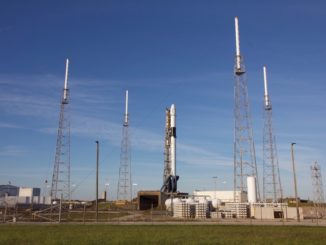Science
SpaceX Launches Falcon 9 Rocket for Record 31st Time

SpaceX is poised to set a new milestone in space exploration by launching its Falcon 9 rocket for a record-breaking 31st time on October 22, 2024. This historic mission will see the Falcon 9 booster, known by its tail number B1067, lift off from Space Launch Complex 40 at Cape Canaveral Space Force Station at 11:49 a.m. EDT (15:49 UTC). The primary objective of this flight is the deployment of the Starlink 10-17 mission.
Weather Conditions Favorable for Launch
According to the 45th Weather Squadron, there is a greater than 95 percent chance of favorable weather conditions during the launch window. Meteorologists have reported no anticipated weather phenomena that could interfere with the flight, promising a clear path for the Falcon 9.
This launch will mark the 30th flight for the Falcon 9 booster supporting the Starlink mission. The previous flight of B1067 occurred on August 28, 2025, for the Starlink 10-11 mission. Following liftoff, SpaceX plans to recover the booster approximately 8.5 minutes later on its drone ship, ‘A Shortfall of Gravitas.’ This recovery will be notable as it represents the 129th booster landing on this vessel and the 520th landing for SpaceX overall.
Advancements in Launch Efficiency
SpaceX continues to push the boundaries of rocket reuse, working towards certifying its Falcon boosters for up to 40 launches and landings. The recent focus on the Starlink satellite constellation has seen B1067 participate in the last seven flights, emphasizing the company’s commitment to expanding its satellite network. The upcoming Starlink 10-17 mission will add an additional 28 satellites to low Earth orbit, contributing to the growing constellation.
Kiko Dontchev, SpaceX’s Vice President of Launch, highlighted the achievement of the last launch from SLC-40, which set a turnaround record. This included the fastest launch-to-launch interval from the same American launch pad, clocking in at just 55 hours, 29 minutes, and 9 seconds, and the quickest transporter erector roll into the hangar for booster integration, at 12 hours, 5 minutes, and 20 seconds.
“I’m confident the SpaceX Falcon team will pull off a sub 48-hour launch-to-launch turnaround from Pad 40 this year,” wrote Dontchev on social media. He also noted the team’s ambitions to break the world record set by the Soviet Union in 1962 with two launches from the same pad in 24 hours, although he acknowledged the differing ground launch systems involved.
As SpaceX approaches this historic launch, the company continues to demonstrate its leadership in the aerospace sector and its commitment to revolutionizing satellite communications through the Starlink initiative. With the Falcon 9’s proven reliability and the focus on rapid reuse, the upcoming mission is set to be another significant step forward in commercial spaceflight.
-

 Health4 days ago
Health4 days agoRare Brain Condition Discovered More Common in New Mexico
-

 Politics5 days ago
Politics5 days agoPrince Andrew Steps Back from Royal Duties Following Epstein Memoir
-

 Sports6 days ago
Sports6 days agoMLS Decision Day 2025: Playoff Spots on the Line as Teams Clash
-

 World5 days ago
World5 days agoYoung Driver Dies in Collision with Box Truck in El Cajon
-

 Science6 days ago
Science6 days agoIdaho State University Launches Haunted Science Laboratory on Oct. 25
-

 Lifestyle6 days ago
Lifestyle6 days agoKent Hamilton Named Southeastern Farmer of the Year at Expo
-

 Health5 days ago
Health5 days agoRemembering Mary Ingleby: A Life of Love, Teaching, and Music
-

 Business5 days ago
Business5 days agoFirst National Bank of Groton’s Quiet Period Ends October 21
-

 Entertainment5 days ago
Entertainment5 days agoTrump Commutes George Santos’ Sentence, Sparks Controversy
-

 Politics6 days ago
Politics6 days agoNavy Veteran Max Quattromani Launches Campaign for Assessor Seat
-

 Sports5 days ago
Sports5 days agoSaquon Barkley Reacts to James Franklin’s Dismissal from Penn State
-

 World6 days ago
World6 days agoHamas to Return Additional Hostage Remains on Friday









